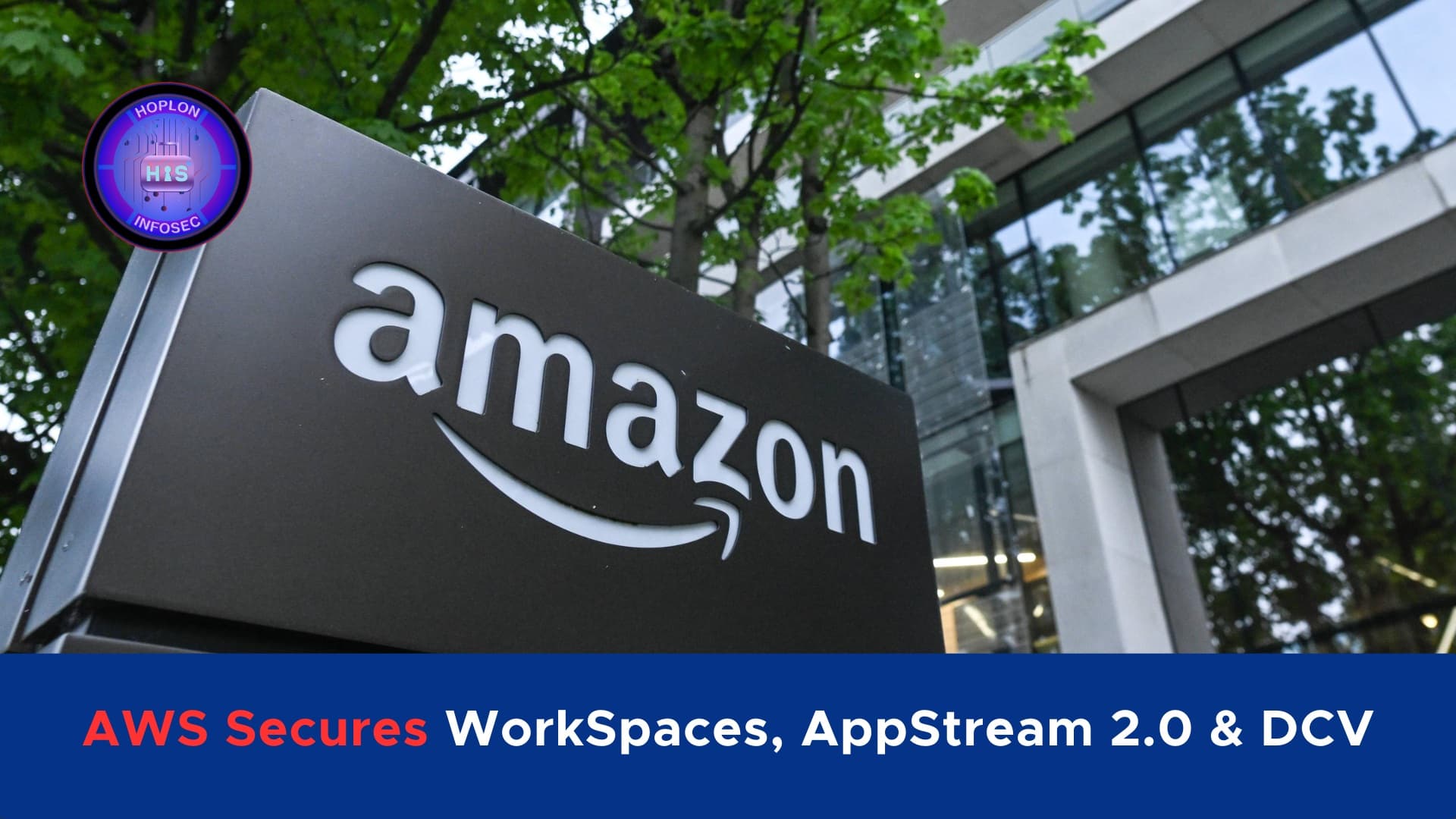AWS Secures WorkSpaces, AppStream 2.0 & DCV with Patches

Hoplon InfoSec
17 Jan, 2025
In an ever-evolving digital landscape, security vulnerabilities remain a pressing concern for organizations and individuals. Amazon Web Services (AWS), a leader in cloud computing solutions, recently tackled two critical security vulnerabilities that could have significant implications for its users. These vulnerabilities, CVE-2025-0500 and CVE-2025-0501, specifically affect Amazon WorkSpaces, Amazon AppStream 2.0, and Amazon DCV (Desktop Cloud Visualization). This blog delves into the details of these vulnerabilities, their potential impact, and AWS’s steps to mitigate them.
Understanding the Vulnerabilities: CVE-2025-0500 and CVE-2025-0501
CVE-2025-0500: A High-Severity Threat
CVE-2025-0500 is a critical vulnerability that impacts specific versions of the native clients for Amazon WorkSpaces, Amazon AppStream 2.0, and Amazon DCV. These clients rely on the Amazon DCV protocol for remote session management. This issue is classified as a high-severity threat with a Common Vulnerability Scoring System (CVSS) v4.0 score of 7.7.
This vulnerability could allow attackers to perform man-in-the-middle (MITM) attacks, gaining unauthorized access to remote sessions. It affects clients across multiple platforms, including Windows, macOS, Linux, and Android, posing a significant risk to users operating within the AWS ecosystem.
CVE-2025-0501: Targeting PCoIP Protocol Users
CVE-2025-0501 specifically affects Amazon WorkSpaces clients that utilize the PCoIP protocol. AWS security experts identified that this vulnerability impacts a broad range of devices, including Windows, macOS, Linux, and Android clients. It could expose users to unauthorized access to their remote WorkSpaces sessions if exploited. The widespread use of the PCoIP protocol for remote desktop solutions heightens the potential impact of this issue.
Technical Analysis and AWS’s Response
AWS has acted swiftly to address these vulnerabilities, releasing patched versions of the affected clients. These updates are designed to eliminate the risk posed by CVE-2025-0500 and CVE-2025-0501, ensuring the continued security and reliability of AWS services.
Mitigation Measures for CVE-2025-0500
To mitigate the risks associated with CVE-2025-0500, AWS recommends the following updates:
- Amazon WorkSpaces: Upgrade to client version 5.21.0 or later for Windows and macOS and version 2024.2 or later for Linux.
- Amazon AppStream 2.0: Update to Windows client version 1.1.1332 or later.
- Amazon DCV: Upgrade to version 2023.1.9127 or later across all platforms.
Mitigation Measures for CVE-2025-0501
For CVE-2025-0501, AWS suggests these updates:
- Amazon WorkSpaces: Upgrade to client version 5.22.1 or later for Windows and macOS, version 2024.6 or later for Linux, and version 5.0.1 or Android.
AWS emphasizes the importance of promptly installing these updates to prevent the exploitation of these vulnerabilities. Organizations can safeguard their cloud environments and maintain operational continuity by taking immediate action.
The Implications of Cloud Security Vulnerabilities
The discovery of these vulnerabilities underscores the challenges of maintaining robust security in a cloud-driven world. As businesses increasingly adopt remote work solutions and cloud-based services, the attack surface for cyber threats continues to expand. Vulnerabilities like CVE-2025-0500 and CVE-2025-0501 highlight the importance of proactive security measures and regular software updates.
The Role of Security in Cloud Adoption
Cloud computing offers numerous benefits, including scalability, cost-efficiency, and accessibility. However, these advantages come with inherent security risks. Organizations must prioritize cybersecurity as a fundamental aspect of their cloud strategy. This includes:
- Regular Updates: Ensuring all software and systems are updated with the latest patches.
- User Education: Training employees to recognize potential security threats.
- Advanced Security Tools: Leverage intrusion detection systems, firewalls, and Encryption to protect sensitive data.
Lessons Learned from AWS’s Response
AWS’s rapid response to these vulnerabilities serves as a model for other service providers. By promptly releasing patches and communicating with customers, AWS demonstrates its commitment to maintaining a secure cloud environment. This approach not only mitigates immediate risks but also builds trust among users.
Best Practices for Cloud Security
To minimize the risk of security breaches, organizations and individuals using cloud-based services should adopt the following best practices:
1. Keep Software Updated
Outdated software is a common entry point for attackers. Regularly updating clients and systems ensures that vulnerabilities are patched promptly.
2. Implement Multi-Factor Authentication (MFA)
Adding an extra layer of authentication makes it significantly harder for attackers to gain unauthorized access.
3. Monitor Network Activity
Regular network traffic monitoring can help detect and prevent malicious activities in real-time.
4. Conduct Security Audits
Periodic security assessments can identify potential weaknesses and ensure compliance with industry standards.
5. Use Encryption
Encrypting data in transit and at rest protects sensitive information from unauthorized access.
6. Educate Users
Awareness is key to preventing social engineering attacks and other user-targeted threats. Provide training sessions to help users recognize phishing attempts and other risks.
AWS’s Commitment to Security
AWS has consistently demonstrated its dedication to providing secure and reliable services. In response to CVE-2025-0500 and CVE-2025-0501, the company has:
- Communicated proactively with customers about the vulnerabilities and necessary updates.
- Released detailed guidance on updating affected clients.
- Ensured continuous monitoring of the situation to prevent further risks.
AWS reinforces its reputation as a trusted cloud solutions provider by taking these steps.
Conclusion
The recent vulnerabilities affecting Amazon WorkSpaces, Amazon AppStream 2.0, and Amazon DCV highlight the dynamic nature of cybersecurity challenges in a cloud-first world. While AWS’s swift action mitigates the immediate risks, this incident reminds us of the importance of vigilance and proactive measures in maintaining cloud security.
As users and organizations, staying informed, updating software regularly, and adhering to best practices are crucial to protecting against evolving cyber threats. AWS’s response to CVE-2025-0500 and CVE-2025-0501 not only resolves these specific vulnerabilities but also reinforces the need for a collaborative approach to cybersecurity in the digital age.
For more:
https://cybersecuritynews.com/aws-patches-multiple-vulnerabilities/
Share this :